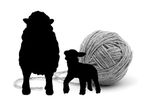Something’s Up
The farmer has to be an optimist or he wouldn’t still be a farmer.
—WILL ROGERS
On most livestock farms, the animals must reproduce because the farmer is in the business of making more of them. For thousands of years we shepherds have been controlling the breeding of our animals, trying to create the finest wool or the tenderest meat. Farmers still do this today; the only difference is that on many farms the male and female never meet.
This virtual speed mating is called artificial insemination. Basically, you have an expensive ram with great genes and a healthy libido. Instead of dragging him all over the planet to visit the ladies, the farmer gives the ram a plastic cup and two back issues of Totally Shorn Ewes, and soon there’s some sperm available. Farmers buy the sperm, a vet inserts it, the ewe walks away, and biology takes over. We, however, run an old-fashioned farm. Because we let the ram and ewe actually meet and actually mate, sheep sex is an exciting event that begins December 17.
As we once again approach this date, we solve the problem of Melissa’s low energy. She’s been anemic for months. No wonder she’s been dragging around the farm. She undergoes a laparoscopic hysterectomy in the fall and as she recovers, the Backup Farmer sproings into action.
The doctor assures us Melissa will be back to her old self in a month. It takes longer than that. For Melissa, recuperation means sneaking out of the house to move things around in the barn until I figure out she’s escaped and am forced to use my Angry Voice to march her back into the house. This happens day after day. I consider handcuffing her to the dining room table. December drags on.
Soon, it’s time. We let the tension build because it helps the ewes start cycling together. To do this, we put our ram Erik on one side of the electric fence and a group of hot-to-trot ewes on the other. We let them pace back and forth along those 5,000 volts for a few weeks until the sexual tension snaps louder than the fence. Then we strap a harness across Erik’s chest that holds a big flat green crayon. Every time he mounts and successfully breeds a ewe, he’ll leave a telltale green mark on her back.
On December 17 we open the gate and Erik rushes toward the ewes. Because a ewe is ready and willing to breed only about every seventeen days, Erik must find those ewes in that part of their cycle today. He sniffs backside after backside, curling his upper lip delicately to better inhale the ewes’ scents. Finally he finds one. She stands still, batting her eyelashes. He mounts. Boom-boomboom. It’s over. The green marker does its job. On this farm, instead of the Scarlet Letter, we have the Viridian Smudge.
Now that there’s been ovine love, there will be babies in five months, in mid-May, and we’ll spin through the cycle of our year again. But as I feed and water the animals every day, I make note of the green smudges. Hmmm. There aren’t many. I stand around watching, huddled against the barn wall to get out of the wind that’s lowering the 20°F temperature down to zero. I massage my face so it doesn’t freeze into a confused scowl. It may sound kinky that I watch our sheep breed, but if something goes wrong with the breeding, something goes wrong with the farm.
My suspicions grow. Other than his first day on the “job,” Erik isn’t getting much “action.” Is he sick? Is he injured? Low on energy? Holding out for some long-legged Swedish ewes?
Something’s up, but it’s clearly not the ram.

